Yearbook of
Astronomy
Yearbook of Astronomy 2024
 Maintaining its appealing style and presentation, the Yearbook of Astronomy 2024 contains comprehensive jargon-free monthly sky notes and an authoritative set of sky charts to enable backyard astronomers and sky gazers everywhere to plan their viewing of the year’s eclipses, comets, meteor showers and minor planets as well as detailing the phases of the Moon and visibility and locations of the planets throughout the year. To supplement all this is a variety of entertaining and informative articles, a feature for which the Yearbook of Astronomy is known.
Maintaining its appealing style and presentation, the Yearbook of Astronomy 2024 contains comprehensive jargon-free monthly sky notes and an authoritative set of sky charts to enable backyard astronomers and sky gazers everywhere to plan their viewing of the year’s eclipses, comets, meteor showers and minor planets as well as detailing the phases of the Moon and visibility and locations of the planets throughout the year. To supplement all this is a variety of entertaining and informative articles, a feature for which the Yearbook of Astronomy is known.
The Yearbook of Astronomy 2024 continues to be essential reading for anyone lured and fascinated by the magic of astronomy. It remains an inspiration to amateur and professional astronomers alike, and warrants a place on the bookshelf of all stargazers and watchers of the Universe.
Articles for the 2024 edition include:
- Recent Advances in Astronomy by Rod Hine
- Recent Advances in Solar System Exploration by Peter Rea
- Anniversaries in 2024 by Neil Haggath
- Astronomy in Antarctica by Michael Burton
- Things Fall Apart: Chaos in the Solar System by David Harper
- Male Mentors for Women in Astronomy by Mary McIntyre
- Communicating from the Edge of the Solar System by Peter Rea
- Skies over Ancient America by P. Clay Sherrod
- Tracking Older Artifical Satellites by Steve Harvey
- Inner Lives of Dead Stars by Matt Caplan
- Riccardo Giacconi: X-ray Astronomy Pioneer by David M. Harland
- The Astronomers' Stars: In the Neighbourhood by Lynne Marie Stockman
- Mission to Mars: Countdown to Building a Brave New World: The Right Stuff at the Right Time by Martin Braddock
- A Triumvirate of Telescope Makers: Thomas Cooke, Howard Grubb and Alvan Clark by John McCue and John Nichol
Bursting with up-to-the-minute information, the Yearbook of Astronomy 2024 is, as ever, essential reading for anyone fascinated by the night sky.
Yearbook of Astronomy 2024 was released on 2 August 2023. It can be ordered directly from the publisher Pen & Sword Books Limited. Readers in the United States and Canada should order their copies from Casemate IPM. It is also available at Amazon and at other online book retailers.
Yearbook of Astronomy 2023
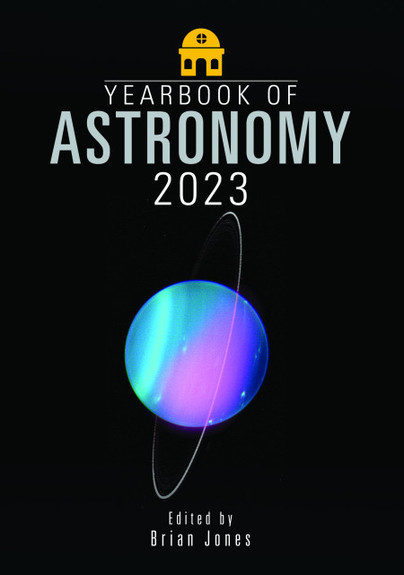 Maintaining its appealing style and presentation, the Yearbook of Astronomy 2023 contains comprehensive jargon-free monthly sky notes and an authoritative set of sky charts to enable backyard astronomers and sky gazers everywhere to plan their viewing of the year’s eclipses, comets, meteor showers and minor planets as well as detailing the phases of the Moon and visibility and locations of the planets throughout the year. To supplement all this is a variety of entertaining and informative articles, a feature for which the Yearbook of Astronomy is known.
Maintaining its appealing style and presentation, the Yearbook of Astronomy 2023 contains comprehensive jargon-free monthly sky notes and an authoritative set of sky charts to enable backyard astronomers and sky gazers everywhere to plan their viewing of the year’s eclipses, comets, meteor showers and minor planets as well as detailing the phases of the Moon and visibility and locations of the planets throughout the year. To supplement all this is a variety of entertaining and informative articles, a feature for which the Yearbook of Astronomy is known.
The Yearbook of Astronomy 2023 continues to be essential reading for anyone lured and fascinated by the magic of astronomy. It remains an inspiration to amateur and professional astronomers alike, and warrants a place on the bookshelf of all stargazers and watchers of the Universe.
Articles for the 2023 edition include:
- Recent Advances in Astronomy by Rod Hine
- Recent Advances in Solar System Exploration by Peter Rea
- Anniversaries in 2023 by Neil Haggath
- Betelgeuse by Tracie Heywood
- Optical SETI at Harvard by David M. Harland
- A Brief History of the End of the Universe by David Harper
- The Evolution of "Multi-Pixel" Radio Telescopes by Rod Hine
- Mission to Mars: Countdown to Building a Brave New World: The Bare Necessities of Life by Martin Braddock
- The Ability to Believe: Bizarre Worlds of Astronomical Antireality by Neil Haggath
- The Astronomers' Stars: Life in the Fast Lane by Lynne Marie Stockman
- Elijah Hinsdale Burritt: Geographer of the Heavens by Richard H. Sanderson
- The Future of Spaceflight by Andrew P.B. Lound
- Male Family Mentors for Women in Astronomy: Caroline and William Herschel by Mary McIntyre
- The Closing of Historic Observatories by Harold A. McAlister
Bursting with up-to-the-minute information, the Yearbook of Astronomy 2023 is, as ever, essential reading for anyone fascinated by the night sky.
Yearbook of Astronomy 2023 was released on 1 August 2022. It can be ordered directly from the publisher Pen & Sword Books Limited. It is also available at Amazon and at other online book retailers.
Yearbook of Astronomy 2022
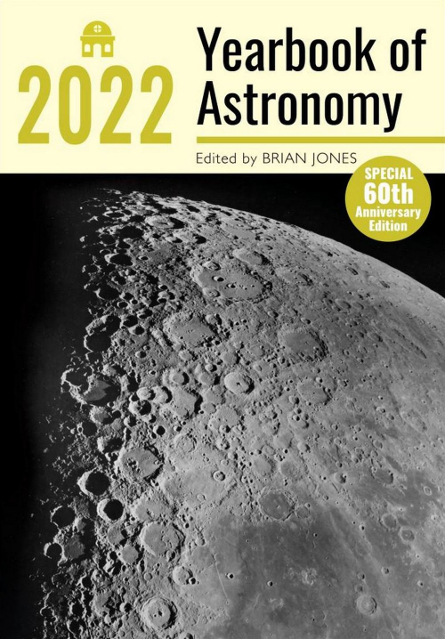 The Yearbook of Astronomy 2022 is the Diamond Jubilee edition of this iconic publication, the annual appearance of which has been eagerly anticipated by astronomers, both amateur and professional, ever since this invaluable book first appeared in 1962. As the preface to the 1962 edition informed its readers, the post-war years had seen a tremendous growth of interest in astronomy and space research. Doubtless fuelled by the dawn of the Space Age, the launch of Sputnik 1 in October 1957 marked a significant change in the course of history. This epoch-making event, coupled with the subsequent flights of Soviet cosmonaut Yuri Gagarin (April 1961) and American astronaut Alan Shepard (May 1961), served to engender a public interest in astronomy and space that has continued to grow and expand to this day.
The Yearbook of Astronomy 2022 is the Diamond Jubilee edition of this iconic publication, the annual appearance of which has been eagerly anticipated by astronomers, both amateur and professional, ever since this invaluable book first appeared in 1962. As the preface to the 1962 edition informed its readers, the post-war years had seen a tremendous growth of interest in astronomy and space research. Doubtless fuelled by the dawn of the Space Age, the launch of Sputnik 1 in October 1957 marked a significant change in the course of history. This epoch-making event, coupled with the subsequent flights of Soviet cosmonaut Yuri Gagarin (April 1961) and American astronaut Alan Shepard (May 1961), served to engender a public interest in astronomy and space that has continued to grow and expand to this day.
Maintaining its appealing style and presentation, the Yearbook of Astronomy 2022 contains comprehensive jargon-free monthly sky notes and an authoritative set of sky charts to enable backyard astronomers and sky gazers everywhere to plan their viewing of the year’s eclipses, comets, meteor showers and minor planets as well as detailing the phases of the Moon and visibility and locations of the planets throughout the year. To supplement all this is a variety of entertaining and informative articles, a feature for which the Yearbook of Astronomy is known.
The Yearbook of Astronomy 2022 continues to be essential reading for anyone lured and fascinated by the magic of astronomy. It remains an inspiration to amateur and professional astronomers alike, and warrants a place on the bookshelf of all stargazers and watchers of the Universe.
Articles for the 2022 edition include:
- Astronomy in 2021 by Rod Hine
- Solar System Exploration in 2021 by Peter Rea
- Anniversaries in 2022 by Neil Haggath
- The Yearbook of Astronomy Cover Image: 1962 and 2022 by Steve Brown
- A History of the Amateur Astronomy Society: 1962 to 2022 by Allan Chapman
- Expanding Cosmic Horizons by Martin Rees
- The Astronomers’ Stars: A Study in Scarlet by Lynne Marie Stockman
- Frank Drake and His Equation by David M. Harland
- Remote Observing and Imaging by Damian Peach
- Skies Over Ancient America by P. Clay Sherrod
- Tycho Brahe and the Parallax of Mars by David Harper
- A Tale of Two Henrys and the Search for Their Great Telescopes by Gary Yule
- Mission to Mars: Countdown to Building a Brave New World: Laying the Foundations by Martin Braddock
- Ad Astra: A Personal Journey by David H. Levy
- Internet Satellites: Less Welcome Constellations? by Bob Mizon
Bursting with up-to-the-minute information, the Yearbook of Astronomy 2022 is, as ever, essential reading for anyone fascinated by the night sky.
Yearbook of Astronomy 2022 was released on 30 October 2021. It can be ordered directly from the publisher Pen & Sword Books Limited. It is also available at Amazon and at other online book retailers.
Yearbook of Astronomy 2021
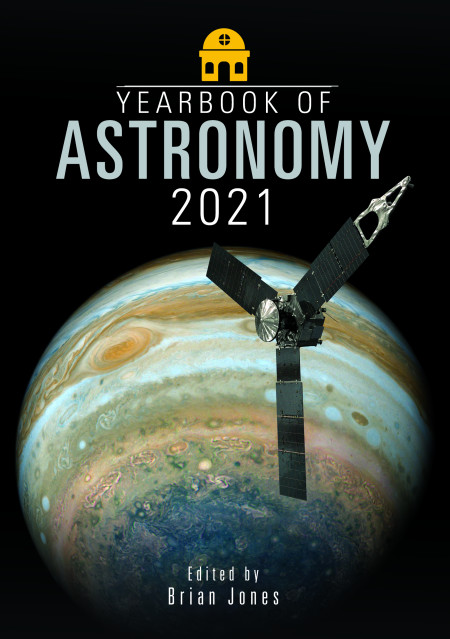 Maintaining its appealing style and presentation, the Yearbook of Astronomy 2021 contains comprehensive jargon-free monthly sky notes and an authoritative set of sky charts to enable backyard astronomers and sky gazers everywhere to plan their viewing of the year's eclipses, comets, meteor showers and minor planets as well as detailing the phases of the Moon and visibility and locations of the planets throughout the year. The ongoing process of improving and updating what the Yearbook of Astronomy offers to its readers is continued in the 2021 edition with the introduction of apparition charts for Mars, Jupiter and Saturn, which ensures that charts are now included for all the major planets in our solar system.
Maintaining its appealing style and presentation, the Yearbook of Astronomy 2021 contains comprehensive jargon-free monthly sky notes and an authoritative set of sky charts to enable backyard astronomers and sky gazers everywhere to plan their viewing of the year's eclipses, comets, meteor showers and minor planets as well as detailing the phases of the Moon and visibility and locations of the planets throughout the year. The ongoing process of improving and updating what the Yearbook of Astronomy offers to its readers is continued in the 2021 edition with the introduction of apparition charts for Mars, Jupiter and Saturn, which ensures that charts are now included for all the major planets in our solar system.
Articles for the 2021 edition include:
- Astronomy in 2020 by Rod Hine
- Solar System Exploration in 2020 by Peter Rea
- Anniversaries in 2021 by Neil Haggath
- Mission to Mars: Countdown to Building a Brave New World by Martin Braddock
- Male Family Members for Women in Astronomy by Mary McIntyre
- Henrietta Swan Leavitt and Her Work by David M. Harland
- Solar Observing by Peter Meadows
- The Meteorite Age by Carolyn Kennett
- "A Dignity That Insures Their Perpetuation" by John C. Barentine
- Lunar Volcanism by Lionel Wilson
- Pages From the Past: Collecting Vintage Astronomy Books by Richard H. Sanderson
- The Chances of Anything Coming From Mars by Jan Hardy
- Māori Astronomy in Aotearoa-New Zealand by Pauline Harris, Hēmi Whaanga and Rangi Matamua
Bursting with up-to-the-minute information, the Yearbook of Astronomy 2021 is, as ever, essential reading for anyone fascinated by the night sky.
Yearbook of Astronomy 2021 is published by Pen & Sword Books Limited. It is also available at Amazon and at other online book retailers.
Yearbook of Astronomy 2020
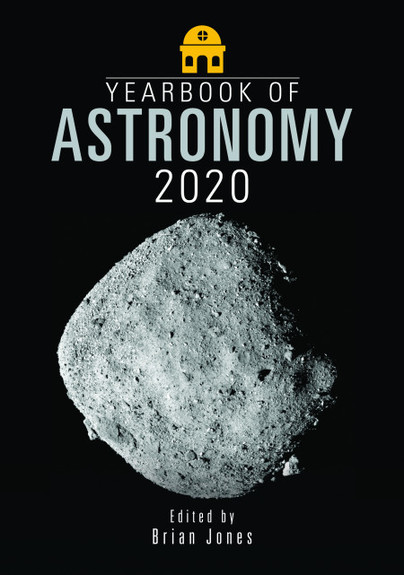 Maintaining its appealing style and presentation, the Yearbook of Astronomy 2020 contains comprehensive jargon-free monthly sky notes and an authoritative set of sky charts to enable backyard astronomers and sky gazers everywhere to plan their viewing of the year's eclipses, comets, meteor showers and minor planets as well as detailing the phases of the Moon and visibility and locations of the planets throughout the year. The 2020 edition of the Yearbook of Astronomy now includes diagrams showing the positions of Mercury and Venus at sunrise or sunset throughout each apparition, as well as finder charts for Uranus and Neptune.
Maintaining its appealing style and presentation, the Yearbook of Astronomy 2020 contains comprehensive jargon-free monthly sky notes and an authoritative set of sky charts to enable backyard astronomers and sky gazers everywhere to plan their viewing of the year's eclipses, comets, meteor showers and minor planets as well as detailing the phases of the Moon and visibility and locations of the planets throughout the year. The 2020 edition of the Yearbook of Astronomy now includes diagrams showing the positions of Mercury and Venus at sunrise or sunset throughout each apparition, as well as finder charts for Uranus and Neptune.
Articles for the 2020 edition include:
- Astronomy in 2019 by Rod Hine
- Solar System Exploration in 2019 by Peter Rea
- Anniversaries in 2020 by Neil Haggath
- 200 Years of the Royal Astronomical Society by Sian Prosser
- The Naming of Stars by David Harper
- Astronomical Sketching by Steve Brown
- Dark Matter and Galaxies by Julian Onions
- Eclipsing Binaries by Tracie Heywood
- The First Known Black Hole by David Harland
- A Perspective on the Aboriginal View of the World by Greg Quicke
- 'Oumuamua — Interstellar Interloper by Neil Norman
- Forgotten on the Moon by Bill Leatherbarrow
Bursting with up-to-the-minute information, the Yearbook of Astronomy 2020 is, as ever, essential reading for anyone fascinated by the night sky.
Yearbook of Astronomy 2020 is published by Pen & Sword Books Limited. It is also available online at Amazon and at other online book retailers.
Bonus Online Material
The 2021 edition of the Yearbook of Astronomy will include finder charts showing the positions of Mars, Jupiter and Saturn throughout the year. To give readers of the 2020 edition a preview of these charts, we have prepared downloadable PDF files for these planets in 2020. There are two charts for Mars. The first shows its progress as a morning-sky object during the first half of the year, starting in Libra and ending in Pisces, a span of more than 120° along the ecliptic. The red planet slows down as it approaches opposition in October 2020, and the second chart is a close-up view of the region of Pisces and Cetus where Mars may be found between July and December 2020. Jupiter and Saturn are both near the border between Sagittarius and Capricornus in 2020, so the charts for Jupiter and Saturn are shown side by side and at the same scale, allowing direct comparison.
Yearbook of Astronomy 2019
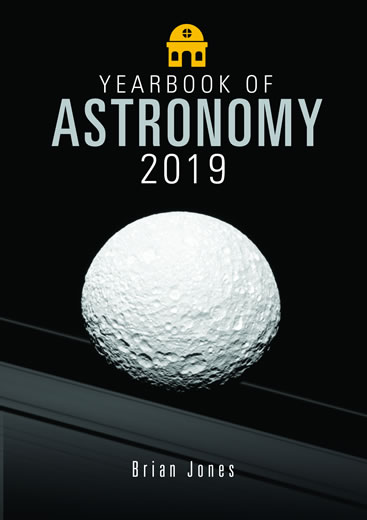 The 2019 edition contains authoritative sky charts and detailed monthly sky notes that plot a clear path though the year's lunar phases, eclipses, comets, meteor showers and minor planets as well as featuring a variety of articles covering a wide range of astronomy- and space-related topics, and much more.
The 2019 edition contains authoritative sky charts and detailed monthly sky notes that plot a clear path though the year's lunar phases, eclipses, comets, meteor showers and minor planets as well as featuring a variety of articles covering a wide range of astronomy- and space-related topics, and much more.
Articles for the 2019 edition include:
- Astronomy in 2018 by Rod Hine
- Solar System Exploration in 2018 by Peter Rea
- Anniversaries in 2019 by Neil Haggath
- The Cassini-Huygens Mission to the Saturn System by Carl Murray
- Science Fiction and the Future of Astronomy by Mike Brotherton
- Asaph Hall: Man of Mars by Neil Norman
- Getting the Measure of Double Stars by John McCue
- 100 Years of the International Astronomical Union by Susan Stubbs
- In Total Support of Einstein: Eddington's Eclipse, 1919 by Neil Haggath
- The First Micro-Quasar by David M Harland
- Father Lucian Kemble and the Kemble Asterisms by Steve Brown
- Mira ‘The Wonderful’ by Roger Pickard
Bursting with up-to-the-minute information, the Yearbook of Astronomy 2019 is, as ever, essential reading for anyone fascinated by the night sky.
Yearbook of Astronomy 2019 is published by Pen & Sword Books Limited. It is also available online at Amazon and at other online book retailers.
Bonus Online Material
The 2020 edition of the Yearbook of Astronomy will include diagrams showing the positions of Mercury and Venus at sunrise or sunset throughout each apparition. To give readers of the 2019 edition a preview of these diagrams, we have prepared a downloadable PDF file of the same diagrams for all of the apparitions of Mercury and Venus during 2019.
The 2020 edition will also include finder charts for Uranus and Neptune. We have prepared a downloadable PDF file of the same charts for the 2019 apparitions of Uranus and Neptune. The charts show the paths of the planets throughout the year. The position of each planet is indicated at opposition and at stationary points, as well as the start and end of the year and on the 1st of April, July and October where these dates do not fall too close to an event that is already marked. On the Uranus chart, stars are shown to magnitude 8; on the Neptune chart, the limiting magnitude is 10. In both cases, this is approximately two magnitudes fainter than the planet itself. Right Ascension and Declination scales are shown for the epoch J2000 to allow comparison with modern star charts.
Yearbook of Astronomy 2018
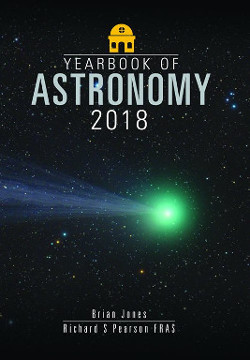 The 2018 edition marks a new chapter in the history of the Yearbook of Astronomy. It is the first edition published by Pen & Sword Books Limited.
The 2018 edition marks a new chapter in the history of the Yearbook of Astronomy. It is the first edition published by Pen & Sword Books Limited.
Articles for the 2018 edition include:
- Solar System Exploration in 2017 by Peter Rea
- Astronomy in 2017 by Rod Hine
- Anniversaries in 2018 by Neil Haggath
- Supermassive Black Holes by David M Harland
- Comets and How to Photograph Them by Damian Peach
- Some Pioneering Lady Astronomers by Mike Frost
- Double and Multiple Stars by John McCue
- Modern Video Astronomy by Steve Wainwright
- Is There Still a Place for Art in Astronomy? by David A Hardy
Yearbook of Astronomy 2018 is published by Pen & Sword Books Limited. It is also available online at Amazon and at other online book retailers.
Yearbook of Astronomy 2017
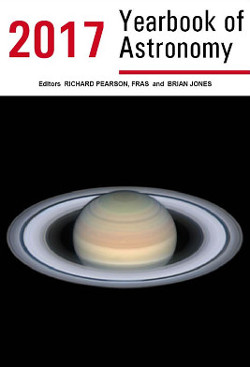 The Yearbook of Astronomy has been an indispensable publication for amateur astronomers for over half a century so when it emerged that the 2016 edition was to be the last one, immediate action was needed to save the book. However, at around this same time, Pen and Sword Books approached Brian Jones about any astronomy book projects he could put their way. They quickly agreed to Brian's suggestion that they take on the Yearbook of Astronomy, starting with the 2018 edition.
The Yearbook of Astronomy has been an indispensable publication for amateur astronomers for over half a century so when it emerged that the 2016 edition was to be the last one, immediate action was needed to save the book. However, at around this same time, Pen and Sword Books approached Brian Jones about any astronomy book projects he could put their way. They quickly agreed to Brian's suggestion that they take on the Yearbook of Astronomy, starting with the 2018 edition.
Although the announcement of a new publisher for the Yearbook of Astronomy was welcome news, this left a one-year gap in the ongoing series of books. In late November 2016, Richard Pearson and Brian decided to self-publish the Yearbook of Astronomy 2017. During the following three months a series of monthly sky notes and star charts was drawn up, information relating to lunar phases, eclipses, comets and minor planets in 2017 was collated, and a number of excellent articles were sourced from contributors who were eager to play their part in saving the Yearbook of Astronomy. The hard work paid off and by late March 2017, the book was on sale.
Articles in the 2017 edition include
- Solar System Exploration in 2016 by Peter Rea
- Astronomy in 2016 by Rod Hine
- Anniversaries in 2017 by Neil Haggath
- High Resolution Planetary Imaging by Damian Peach
- Minor Planets in 2017 by Neil Norman
- Comets in 2017 by Neil Norman
- Why Variable Stars? by Roger Pickard
- Nicolas Louis De La Caille: Bringing Order to the Southern Skies by Brian Jones
Copies of the 2017 edition are still available at Starlight Nights.
Glossary
The 2018-2021 editions of the Yearbook of Astronomy include a Glossary at the back of the book. However, due to the increasing length of the Glossary, it has been decided to remove it from the book and instead publish it on the Yearbook of Astronomy website in the form of a downloadable PDF.
Readers of the Yearbook are invited to read through the Glossary and, if they feel that any important terms or definitions are missing, they may submit new entries. These should include the word or term itself along with the accompanying descriptive/explanatory text. If approved for use, they will be inserted into the online Glossary, and the name of the contributor will be added to this page. We reserve the right to edit contributions to conform to the style of the Yearbook.
Please send any proposed new Glossary entries to us via the Contact page on this website.
Readers who have contributed to the Glossary
- John McCue
- Mary McIntyre
Index of Articles
The Yearbook of Astronomy is much more than just an annual guide to the night sky. Since the very first edition in 1962, over 500 articles have appeared in its pages. They cover a wide range of astronomy- and space-related topics, and have been written by many experienced astronomers, both professional and amateur.
Given the potential value of these articles to the reader, we have compiled a full index which lists the articles by author.
The index, which is provided here in the form of a downloadable PDF, includes all of the articles which have appeared in the main 'Article Section' of the Yearbook as well as the shorter articles contained in the Monthly Sky Notes section from the 2018 edition onwards. If you check through the index, you are sure to find something that will have you seeking out one or more previous editions of the Yearbook of Astronomy!
Errata
The Editor would be grateful if readers could notify him of any errors via the contact form on this web site.
Yearbook of Astronomy 2021
- Solar System Exploration in 2022 by Peter Rea (page 219 of the printed edition)
- The section entitled "Rosalind Franklin goes to Mars" was written — and the book went to print — before this mission was delayed from the 2020 launch opportunity. The mission has been rescheduled for the next Mars launch window in 2022 and this section will reappear, with amendments, in the Yearbook of Astronomy 2023
Yearbook of Astronomy 2020
- Anniversaries in 2020 by Neil Haggath (page 209 of the printed edition)
- The section commemorating Eugène Michel Antoniadi states that he is one of only two astronomers — the other being Giovanni Schiaparelli — to be honoured with named features on the Moon, Mars and Mercury. There are in fact three. Gerard Kuiper (1905–1973) also has craters named for him on all three bodies.
Yearbook of Astronomy 2019
- Minor Planets in 2019 by Neil Norman (page 155 of the printed edition)
- The sentence which begins Hebe has a high bulk density and contains around 50% of the mass of the asteroid belt should read Hebe has a high bulk density and contains around 0.5% of the mass of the asteroid belt.
- The First Micro-Quasar by David M. Harland (page 258 of the printed edition)
- The sentence These were taken on the nights of 13, 14, 15 and 17 July 1978 should read These were taken on successive nights between 13 and 16 July 1978.
Yearbook of Astronomy 2018
- Some Pioneering Lady Astronomers by Mike Frost (page 209 of the printed edition)
- The article contains an illustration sourced from the Indian Institute of Astrophysics Archives, Bangalore, of the staff of the Kodaikanal Observatory, Tamil Nadu, India, circa 1907. The four westerners at the centre of the photograph are identified as (left-to-right) Michie Smith (the first director of the Observatory), Michie Smith’s sister Lucy, John Evershed, and Mary Evershed, the first lady pioneer featured in the article. A recent biography of Mary Evershed, Dante and the Early Astronomer: Science, Adventure, and a Victorian Woman Who Opened the Heavens by Tracy Daugherty (Yale University Press, 2019), makes a different identification. Mary and John Evershed are at the centre of the picture, and the other two westerners, sitting to either side of John and Mary, are John Evershed’s assistant T. Royds and his wife. The biography contains several other photographs of Mary Evershed, which confirm Daugherty’s identification.
- Glossary entry for Magnitude (page 293 of the printed edition)
- The sentence In 1856 the English astronomer Norman Robert Pogson refined the system devised by Hipparchus by classing a 1st magnitude star as being 100 times as bright as one of 6th magnitude, giving a difference between successive magnitudes of 5Ö100 or 2.512 should read In 1856 the English astronomer Norman Robert Pogson refined the system devised by Hipparchus by classing a 1st magnitude star as being 100 times as bright as one of 6th magnitude, giving a difference between successive magnitudes of 5√100 or 2.512.
Contact
Copyright © 2018–2023 by Brian Jones
and David Harper
Yearbook cover images from 2018 onwards copyright © 2018–2023 by Pen & Sword Books
All Rights Reserved
Unauthorised reproduction in part or in whole in any format is prohibited without the written consent of the authors.
Designed and maintained by
Obliquity